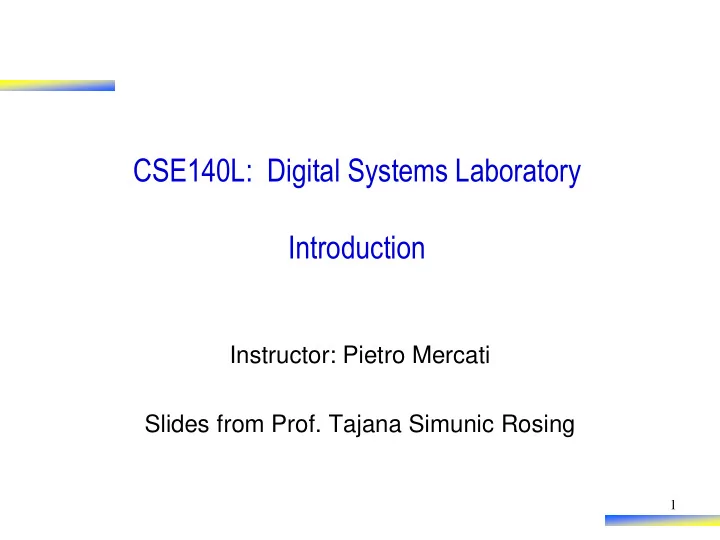

CSE140L: Digital Systems Laboratory Introduction Instructor: Pietro Mercati Slides from Prof. Tajana Simunic Rosing 1
Welcome to CSE 140L! • Instructor: Pietro Mercati • Email: pimercat@eng.ucsd.edu; – please put “CSE140L” in the subject line • Office Hours: – Mon 2-4pm CSE 2109 • Website : https://cseweb.ucsd.edu/classes/su16_2/cse140L-a/index.html – Homeworks and slides will be here • TAs and Tutors – Office hours listed on the class website/Piazza • Discussion sessions: Thu 5-6pm (Only if requested, otherwise is a lab office hour) • Grades: https://tritoned.ucsd.edu/ • Announcements and online discussion : https://piazza.com – “CSE140L_S216_MERCATI” SIGN UP SOON !!! • Lab : B250 2
Course Description • Prerequisites: – CSE 20 or Math 15A, and CSE 30. – CSE 140 must be taken concurrently • Objective: – Introduce digital components and system design concepts through hands-on experience in a lab • Grading: – Homeworks (5): #1: 0%, #2,#3,#4: 10%, #5: 20% – Final: 50% • Homeworks: – Can be solved individually or in teams of two. – Each homework solution should be checked-off with a tutor or a TA before the end of the day on the due date – Detailed instructions will be provided on the homework 3
Textbook and Recommended Readings • Recommended textbook: – Contemporary Logic Design by R. Katz & G. Borriello • Recommended textbook: – Digital Design by F. Vahid • Lecture slides are derived from the slides designed for both books 4
Demo Overview 5
Outline • Transistors – How they work – How to build basic gates out of transistors – How to evaluate delay 6
Combinational circuit building blocks: Transistors, gates and timing 7
Switches • Electronic switches are the basis of binary digital circuits – Electrical terminology • Voltage : Difference in electric potential 4.5 A – + between two points 9V 4.5 A – Analogous to water pressure • Current : Flow of charged particles 2 ohms – Analogous to water flow 9V • Resistance : Tendency of wire to resist 0V current flow 4.5 A – Analogous to water pipe diameter • V = I * R (Ohm’s Law) “Binary Digital” = all values are either 0 (low voltage) or 1 (high voltage) 8
The CMOS Switches • CMOS circuit (Complementary – MOS) – Consists of N and PMOS transistors – Both N and PMOS are similar to basic switches – Rp ~ 2 Rn => PMOS in series is much slower than NMOS nMOS 1 0 gate conducts does not conduct pMOS 1 0 gate Silicon -- not quite a conductor or insulator: Semiconductor does not conducts 1 = high voltage conduct 9 0 = low voltage
MOSFET Dimensions Metal Oxide Semiconductor Field Effect Transistor (MOSFET) 10
CMOS delay: resistance • Resistance: – Function of: • resistivity r, thickness t : defined by technology • Width W, length L: defined by designer – Approximate ON transistor with a resistor • R = r’ L/W • L is usually minimum; change only W Resistor approximation 11 [wikipedia] Source: Prof. Subhashish Mitra
CMOS delay: capacitance & timing estimates • Capacitor – Stores charge 𝑅 = 𝐷 𝑊 (capacitance C; voltage V) 𝑒𝑅 𝑒𝑊 𝑒𝑢 = 𝐷 – Current: 𝑒𝑢 • Timing estimate 𝑒𝑊 𝑒𝑊 𝑒𝑊 – 𝑒𝑢 = 𝐷 = 𝐷 (𝑊/𝑆) = 𝑆 𝐷 𝑗 𝑊 • Delay: time to go from 50% to 50% of waveform 12 Source: Prof. Subhashish Mitra
Charge/discharge in CMOS • Calculate on resistance • Calculate capacitance of the gates circuit is driving • Get RC delay & use it as an estimate of circuit delay 𝑢 − 𝑊 𝑝𝑣𝑢 = 𝑊 𝑒𝑒 ( 1 − 𝑓 𝑆𝑞𝐷 ) • Rp ~ 2Rn 13 Source: Prof. Subhashish Mitra
Rules for making gates 14
Another way of making CMOS gates 15
CMOS Example 16
A CMOS design example • Implement F using CMOS: F=A*(B+C) 17
What we’ve covered thus far • Delay estimates • Transistor design • Building basic gates from CMOS 18
Recommend
More recommend